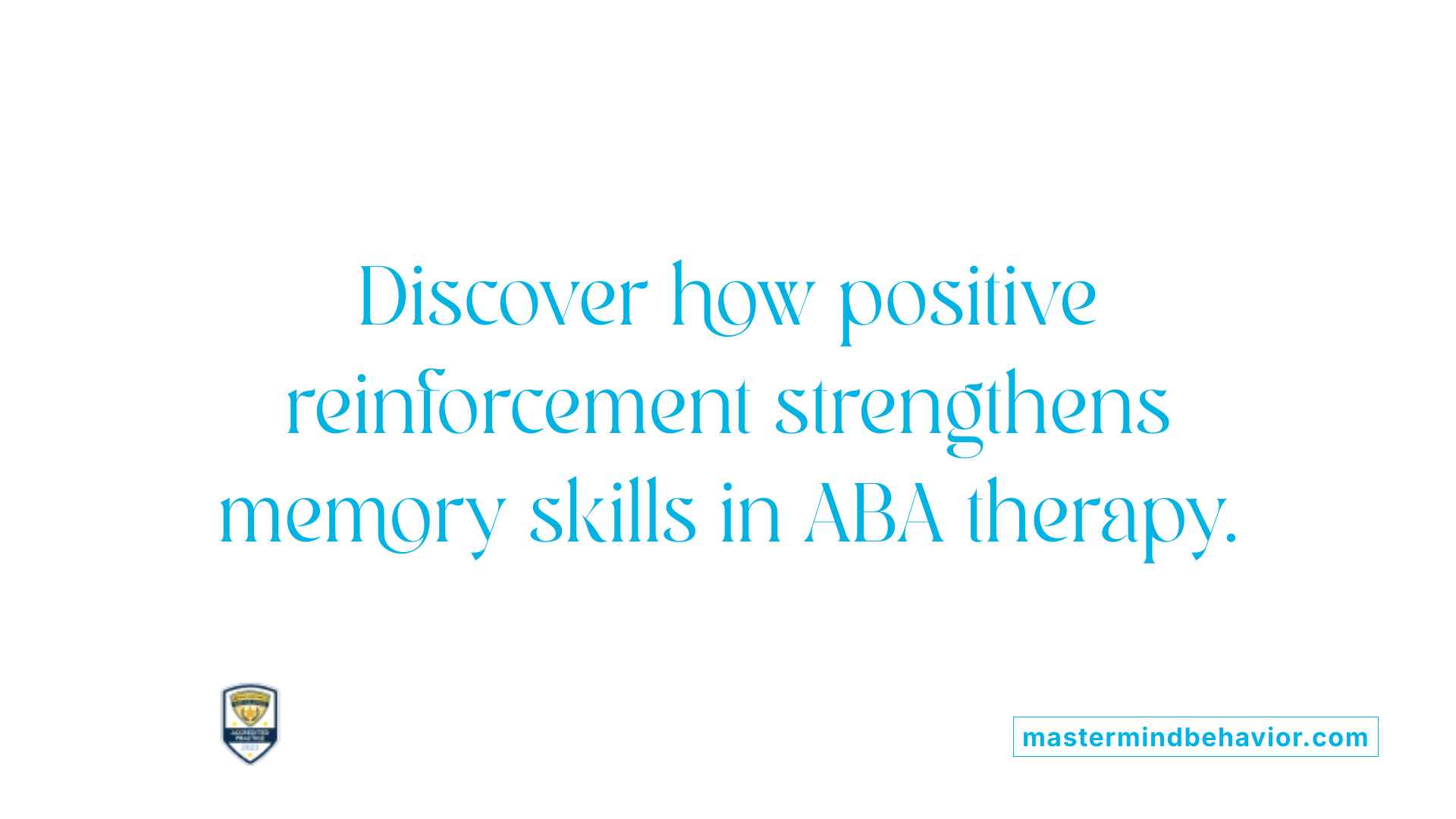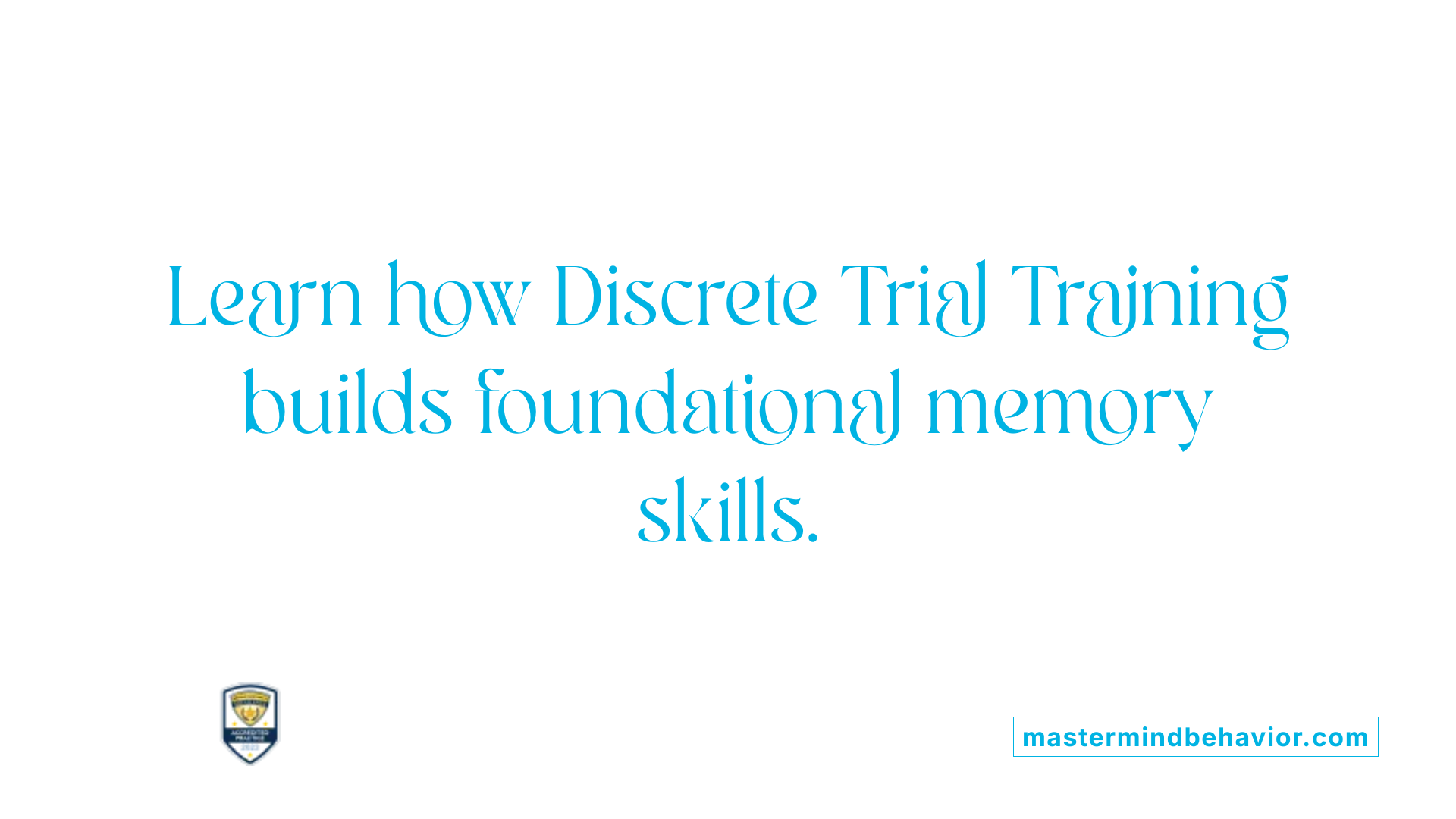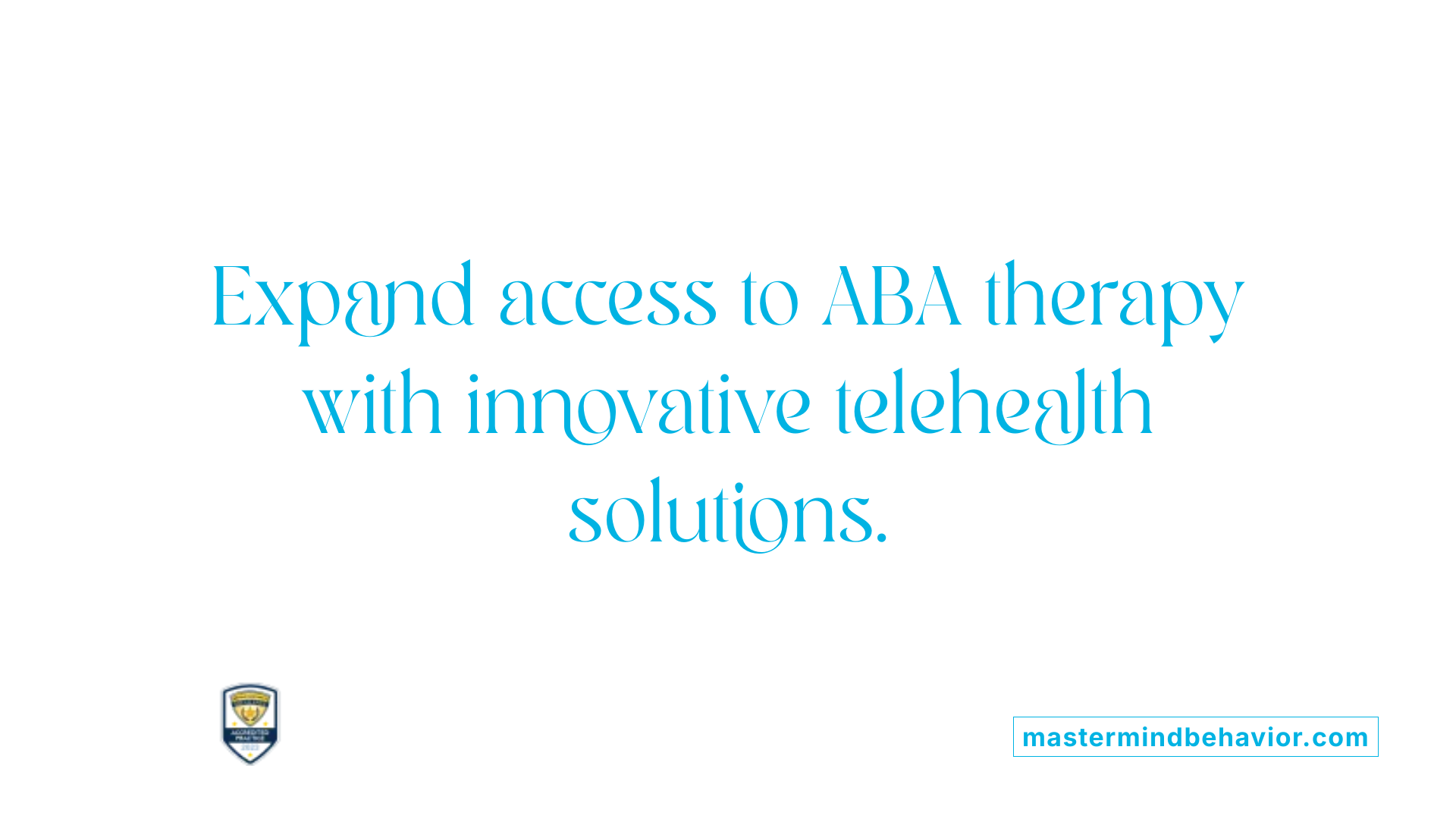An Overview of ABA Therapy and Its Role in Memory Development
Applied Behavior Analysis (ABA) therapy is a scientifically validated approach widely recognized for its effectiveness in supporting individuals with autism spectrum disorder (ASD). This article explores how ABA therapy techniques can be specifically utilized to teach and strengthen memory strategies, enabling learners to improve their cognitive and daily functioning. Through structured interventions, positive reinforcement, and personalized programming, ABA offers promising methods to promote memory skills critical for academic success and independence.
Understanding ABA Therapy: Foundations and Goals
What is Applied Behavior Analysis (ABA) therapy?
Applied Behavior Analysis (ABA) therapy is a scientifically grounded approach aimed at improving specific skills and reducing problematic behaviors. Primarily used for individuals with autism and other developmental challenges, ABA uses detailed assessments to tailor interventions to each person's unique needs.
Definition and principles of ABA therapy
Rooted in behaviorism and operant conditioning, ABA therapy applies systematic strategies to encourage positive behaviors and decrease harmful or ineffective ones. Central to its methodology is the analysis of antecedents, behaviors, and consequences (ABC), which helps in understanding and modifying behavior systematically.
Role of positive reinforcement
A cornerstone of ABA is positive reinforcement, where desirable behaviors are rewarded to encourage their recurrence. This technique supports the development of communication, social skills, learning, and daily living abilities by consistently providing motivating rewards.
Behaviorism and operant conditioning
ABA originates from the principles of behaviorism, particularly from the work of B.F. Skinner and J.B. Watson. Operant conditioning—the process of shaping behavior through consequences such as rewards and consequences—is fundamental in molding behaviors that support independence and functional skills.
ABA as an evidence-based treatment for autism
ABA is widely recognized as a "gold standard" for autism treatment, backed by extensive research showing improvements in language, cognition, and social functioning. Interventions under ABA are data-driven, with ongoing monitoring and program adjustments carried out by qualified professionals to ensure effective and personalized care.
Through these principles and strategies, ABA therapy seeks not only to teach new skills but also to help individuals generalize these skills across various settings for improved independence and quality of life.
ABA Therapy’s Impact on Autism: Enhancing Core Skills
How does ABA therapy help individuals with autism?
ABA therapy systematically promotes development by teaching new skills and reducing problematic behaviors. It relies on positive reinforcement and thorough data collection to adjust strategies based on individual progress.
Improvements in language, cognition, and social skills
Research shows that ABA significantly boosts language development by teaching communication through the Verbal Behavior approach and Functional Communication Training. Cognitive skills improve as complex tasks are broken down using techniques like Chaining. Social skills and interactions are encouraged through play-based methods such as Pivotal Response Training, fostering motivation and social initiation.
Reduction of problematic behaviors
ABA targets problematic behaviors by understanding their triggers and replacing them with functional communication or more appropriate alternatives. Techniques like Functional Behavior Assessment and Antecedent-Based Intervention modify environments and responses to effectively manage and minimize challenging behaviors.
Individualized and early intervention approaches
Early Intensive Behavioral Intervention (EIBI) and customized ABA programs tailored to each child's preferences and skill levels maximize developmental gains. Early, intensive therapy correlates with improvements in IQ, adaptive behaviors, and overall outcomes.
Integration of family training
ABA includes caregiver training, which equips families with tools to support learning and behavior management in natural settings. Parent-mediated interventions and telehealth delivery expand access while ensuring consistent reinforcement across environments.
These combined approaches make ABA a comprehensive, evidence-based treatment that enhances communication, cognition, social interaction, and independence in individuals with autism through personalized and data-driven methods.
Memory Challenges in Autism and the Need for Focused Strategies
What Are Common Memory Difficulties in Individuals with ASD?
Many individuals with autism spectrum disorder (ASD) experience difficulties with various types of memory, including working memory, verbal memory, and visual memory. These challenges can affect how they retain and retrieve information, which impacts communication, social interactions, and learning new skills. For example, difficulties in recalling sequences or instructions may hinder daily functioning and academic progress.
Why Is Memory Important for Learning and Independence?
Memory plays a crucial role in acquiring and applying new skills, which supports independence. Effective memory allows individuals to remember routines, follow instructions, and generalize skills across different settings. Without strategies to support memory, learning new tasks can be slow and frustrating, reducing opportunities for communication and self-help abilities needed for independent living.
How Can ABA Therapy Support Memory Improvement?
ABA therapy uses positive reinforcement and structured teaching methods tailored to an individual's needs, which can help improve memory-related skills. Techniques like Discrete Trial Training (DTT) and Natural Environment Teaching (NET) break down complex tasks into smaller steps, systematically reinforcing each part to aid retention. Functional Communication Training (FCT) and Pivotal Response Training (PRT) incorporate play and motivation, encouraging engagement and better memory through meaningful interactions. Moreover, ABA programs use data-driven approaches to track progress and adjust interventions, ensuring strategies effectively address memory challenges. This personalized and supportive framework fosters skill acquisition and helps individuals with ASD build the memory capacity essential for learning and greater independence.
Customized Assessment in ABA to Address Memory Skills
What is the typical process involved in an ABA therapy program?
An ABA therapy program typically begins with a comprehensive behavioral assessment to identify an individual's strengths and challenges, including aspects related to memory. Using interviews, direct observation, and standardized tools, clinicians gather detailed information about current skills and behaviors.
Comprehensive behavioral assessments
These assessments focus on analyzing antecedents, behaviors, and consequences (ABC analysis) to understand what triggers and maintains specific behaviors. This approach helps detect memory-related difficulties that may influence learning and behavior.
Identifying memory-related strengths and deficits
By evaluating how the individual responds in various contexts, a behavior analyst can pinpoint specific memory-related strengths and deficits. This precise understanding guides which memory skills require support or enhancement.
Individualized goal setting for memory improvement
Based on the assessment, individualized goals targeting memory and related cognitive functions are developed. Goals might involve improving short-term retention, recall abilities, or using memory aids, aligned with the person’s developmental profile and daily needs.
Use of ABC (antecedent-behavior-consequence) analysis
ABC analysis is central to ABA assessment; it provides clarity on how antecedents (events before a behavior) or consequences (events after) affect memory-related behaviors. Adjusting these can promote better memory retention and skill acquisition.
This structured, data-driven assessment process ensures that ABA interventions for memory are personalized, effective, and continuously adapted to promote meaningful improvements in daily functioning.
Positive Reinforcement: Central to Teaching Memory Strategies

How does positive reinforcement work in ABA?
Positive reinforcement is a fundamental element in Applied Behavior Analysis (ABA) therapy. It operates on the principle of rewarding desirable behaviors to increase their likelihood of recurring. In practical terms, when a learner demonstrates a target memory skill or strategy, ABA practitioners immediately provide a reward or positive feedback. This reward may be anything the individual values, such as praise, tokens, or a favorite activity.
How are rewards applied to motivate learners?
In ABA therapy, rewards are carefully chosen based on the learner's preferences to maximize motivation. For memory tasks, every successful attempt can trigger a reinforcement, encouraging the learner to continue trying. Therapists use data collection and observation to identify which rewards best promote engagement and positive outcomes. By tailoring rewards to the individual, ABA ensures that motivation remains high throughout the learning process.
How does positive reinforcement encourage repetition and mastery of memory tasks?
Repeated practice is essential for mastering memory strategies. Positive reinforcement reinforces each correct memory response, making it more likely the behavior will be repeated. Over time, this consistent reward system helps learners not only acquire but also generalize memory skills across settings. Furthermore, the use of enjoyable and meaningful reinforcers fosters a positive learning environment conducive to mastery and long-term retention.
Discrete Trial Training (DTT) for Memory Skill Acquisition

Step-by-step skill breakdown
Discrete Trial Training (DTT) involves breaking down complex memory tasks into small, manageable steps. This approach makes learning easier by focusing on one element at a time, allowing children to master each part before moving on.
Systematic teaching of memory tasks
DTT uses a structured teaching method that presents information systematically. Each trial has a clear beginning and end, providing repeated practice in a controlled setting. This repetitive format helps reinforce memory skills effectively.
Use of antecedents, behaviors, and consequences
A fundamental part of DTT is the ABC model: antecedents, behaviors, and consequences. Teachers provide cues or prompts (antecedents) to elicit a specific memory response (behavior). When the correct response occurs, it is followed by positive reinforcement (consequences), such as praise or rewards, encouraging the child to repeat the behavior.
Effectiveness in foundational memory skills
Research shows DTT is highly effective in teaching foundational memory skills to children with autism. By consistently applying its structured steps and reinforcement strategies, children improve their ability to recall information and develop stronger cognitive skills necessary for everyday functioning.
Natural Environment Training (NET) to Promote Generalization of Memory Skills

Teaching in natural and motivating contexts
Natural Environment Training (NET) is a specialized ABA approach that uses a child’s everyday surroundings and routines as teaching moments. The goal is to make learning meaningful and relevant by embedding memory tasks within naturally occurring activities, thus enhancing the likelihood that new skills will be used outside of therapy sessions.
Using child interests to support memory tasks
NET capitalizes on each child’s unique interests and preferences, which increases motivation and engagement during learning. By incorporating favorite toys, games, or topics into memory exercises, NET helps children feel more motivated to participate. This individualized approach supports stronger retention and recall because the tasks are enjoyable and personally significant.
Encouraging real-life application of memory strategies
A core feature of NET is encouraging children to apply memory techniques in their daily lives. For example, a child might practice remembering a sequence of steps needed to complete a familiar activity, such as making a snack or getting dressed. By rehearsing memory strategies directly where they are useful, NET promotes generalization—meaning children can transfer and adapt what they learn across settings, enhancing independence and functionality.
Functional Communication Training (FCT) and Its Relation to Memory
Reducing Problematic Behaviors by Improving Communication
Functional Communication Training (FCT) is a strategy within ABA therapy designed to replace challenging or problematic behaviors with functional and appropriate communication methods. This often involves teaching individuals to use speech, sign language, or picture exchange systems to express their needs or desires. By providing a more effective way to communicate, FCT reduces frustration and behavioral issues that arise from an inability to convey wants or feelings.
Supporting Working Memory Through Functional Language Use
FCT inherently engages working memory as individuals learn and apply new communicative responses in real-time social interactions. Using language functionally requires keeping track of conversational cues, remembering learned symbols or words, and recalling appropriate responses. This practice strengthens memory systems by repeatedly exercising the ability to hold and manipulate information during communication.
Enhancing Memory-Linked Expressive Skills
By focusing on teaching language based on its purpose—the mandate, tact, intraverbal, and echoic categories—FCT enhances expressive language skills that are closely tied to memory processes. Expressive skills require retrieval and use of stored information, which boosts both short-term and long-term memory functions. As individuals master these communication skills, they not only reduce problematic behaviors but also improve their ability to remember and effectively express thoughts, fostering greater independence and social success.
Pivotal Response Training (PRT) to Enhance Motivation and Memory
Targeting pivotal developmental areas
Pivotal Response Training (PRT) focuses on crucial developmental areas that impact broad learning outcomes, especially motivation and social initiation. By addressing these core areas, PRT aims to spur improvements across multiple skills in children with autism spectrum disorder (ASD).
Play-based natural reinforcement
A hallmark of PRT is its use of play-based, natural reinforcement strategies. Instead of traditional structured teaching, PRT encourages learning in engaging, playful contexts where rewards are naturally tied to the activities. This approach helps maintain the child's interest and makes skill acquisition more enjoyable.
Link between motivation and memory improvement
Enhancing motivation through PRT is directly associated with better memory and retention of learned skills. When children are motivated and actively engaged via natural reinforcers, they tend to remember and generalize behaviors more effectively. This connection makes PRT a powerful intervention for strengthening both social and cognitive abilities in ASD.
Token Economy Systems and Memory Reinforcement
Using Tokens as Motivators for Memory Task Completion
Token Economy Systems in ABA therapy use tokens as symbolic rewards that children can earn by completing desired behaviors, including memory tasks. These tokens can later be exchanged for preferred items or activities, making the process of memory practice more motivating and engaging. This approach helps link the completion of cognitive tasks with immediate positive reinforcement, encouraging consistent participation.
Building Consistent Memory Routines
By systematically awarding tokens for performing memory-related activities, ABA therapy helps establish predictable routines. Consistency is critical for memory reinforcement, as repeated practice supported by immediate rewards strengthens learning. Over time, children become more likely to engage in memory tasks willingly, which supports long-term retention and skill acquisition.
Linking Reinforcement to Cognitive Tasks
The token economy directly ties reinforcement to the successful completion of cognitive goals, such as recalling information or following multi-step instructions. This connection helps children understand the value of memory work and how their efforts lead to positive outcomes. As a result, ABA therapy not only improves memory skills but also builds motivation and confidence through structured reward systems.
Behavioral Techniques for Memory Development: Chaining and Prompting
Breaking Complex Memory Tasks into Smaller Steps
Chaining is a behavioral technique that breaks down complex memory tasks into a series of smaller, manageable steps. Each step, or "link," is taught systematically, allowing learners to master one part before moving to the next. This stepwise progression simplifies the learning process and helps build confidence.
Systematic Prompting to Support Recall
Prompting is used alongside chaining to support recall at each step. It involves giving cues or assistance to encourage the learner to perform the desired behavior or recall specific information. Prompts can be gradually faded over time, encouraging independence and reducing reliance on assistance.
Building Independence Through Stepwise Learning
By combining chaining with systematic prompting, learners gradually internalize the entire sequence, which promotes independence. Over time, the learner performs each step and the entire task without external support, leading to better retention and application of memory skills in daily life. This method is particularly effective in teaching functional tasks and memory sequences in a clear, structured way.
Antecedent-Based Interventions to Prevent Memory-Related Problem Behaviors
How can modifying the environment reduce memory-related frustration?
Antecedent-Based Interventions (ABI) focus on changing the environment before a behavior occurs, particularly to reduce memory-related frustrations that might lead to problem behaviors. By adjusting surroundings, caregivers and therapists can create supportive settings where individuals with autism or memory challenges feel less overwhelmed.
Modifications may include reducing distractions, simplifying tasks, and providing clear, predictable routines. These environmental changes help minimize confusion and ease cognitive load, thus preventing frustration that arises when memory demands exceed capacities.
What role do visual schedules and environmental cues play?
Visual schedules and environmental cues are powerful antecedent tools used in ABA therapy to support memory and behavior management. Visual schedules provide a concrete representation of activities and expectations, helping individuals anticipate what comes next and reducing anxiety tied to uncertainty.
Environmental cues, such as labeled storage, color-coded areas, and signs, serve as constant prompts that aid in recall and decision-making. They guide behavior naturally and independently, fostering confidence and reducing reliance on verbal reminders.
How can antecedent modifications support working memory?
Working memory challenges can lead to confusion and behavioral difficulties. Antecedent modifications help by structuring tasks in a way that lightens working memory demands. Breaking complex instructions into smaller steps, providing timely prompts, and using checklists are common strategies.
These proactive adjustments enable individuals to focus on one step at a time, improving success rates and reducing frustration-triggered problem behaviors. The approach empowers individuals to manage tasks effectively within their memory limits.
Overall, these antecedent-based strategies are essential components of ABA therapy, promoting smoother daily functioning and positive behavioral outcomes through thoughtful environmental and instructional design.
Role of Caregiver Training in Supporting Memory Strategy Learning

Training families to reinforce memory tasks
Caregiver training is a vital component of ABA therapy that enables families to actively support memory strategy learning at home. Therapists teach caregivers how to use positive reinforcement and structure memory tasks effectively, ensuring that learning continues beyond therapy sessions. This hands-on training equips caregivers with practical techniques to prompt, encourage, and reward memory-related behaviors, making memory practice a consistent part of daily routines.
Promoting consistency across environments
ABA emphasizes the importance of consistency, which is crucial for memory retention and skill acquisition. Training caregivers to apply the same memory strategies and reinforcement methods used in clinical settings helps create a uniform learning environment. This consistency across home, school, and community settings reduces confusion for the learner and strengthens the association between the memory strategies and desired behaviors.
Enhancing generalization and maintenance
One of the aims of caregiver involvement is to enhance generalization — the ability to apply memory skills in varied, real-life contexts — and maintenance over time. When caregivers are trained to integrate memory strategies naturally into everyday activities, learners are more likely to retain and use these skills independently. Such involvement also supports ongoing data collection and progress monitoring, allowing for timely adjustments to interventions tailored to individual needs.
Technological Innovations Assisting ABA-Based Memory Interventions
Software for Skill Assessment and Progress Tracking
Modern ABA therapy increasingly relies on specialized software to enhance the assessment and tracking of skills. These tools help therapists and caregivers systematically evaluate a learner’s current abilities, set individualized goals, and monitor progress. By leveraging data analytics and machine learning, these programs can predict the most effective interventions and customize learning plans, thereby improving the efficiency and precision of ABA-based approaches.
Digital Therapeutics and Gaze-Contingent Eye Tracking
Emerging digital therapeutics are revolutionizing ABA interventions by incorporating gaze-contingent eye tracking technology. This method allows the system to monitor where and how a learner’s attention is directed, adapting tasks dynamically to encourage engagement and support memory retention. Eye tracking helps identify visual attention patterns and tailor interventions to optimize learning outcomes, making therapy more interactive and responsive to the learner's needs.
Use of Socially Assistive Robots to Engage Learners
Socially assistive robots represent an innovative approach to ABA therapy, particularly for memory and cognitive skill development. These robots engage children through play-based interactions, which are both motivating and enjoyable. By using naturalistic, social cues, they foster communication and social initiation while reinforcing positive behaviors. Their novel, technology-driven interaction serves to maintain interest and support consistent practice, critical for memory enhancement in ABA programs.
Telehealth Models Expanding Access to Memory-Focused ABA Therapy

Remote Delivery of ABA Sessions
Telehealth has emerged as a vital model for delivering ABA therapy remotely, extending the reach of highly specialized interventions to individuals regardless of location. Through video conferencing and online platforms, therapists can conduct ABA sessions centered on memory strategies and other skill areas. This approach allows for consistent, flexible therapy without the usual barriers of travel or facility access.
Parent-Mediated Interventions
A significant benefit of telehealth ABA services is the capacity for parent-mediated interventions. Caregivers receive direct coaching and training during sessions, empowering them to reinforce memory-focused ABA techniques in everyday settings. This parental involvement not only supports skill generalization but also fosters a collaborative, supportive learning environment tailored to the child's unique needs.
Digital Customization of Memory Strategies
The integration of digital tools and software enhances ABA therapy by customizing memory-related interventions. These technologies assist in skill evaluation, progress tracking, and program adaptation based on real-time data. Machine learning algorithms further personalize therapy plans, optimizing memory task difficulty and reinforcement schedules to suit individual learning patterns and maximize outcomes.
Through telehealth, ABA therapy for memory skills becomes more accessible, personalized, and collaborative, improving the potential for lasting behavioral and cognitive improvements.
Qualified Professionals Delivering ABA Therapy
Who provides ABA therapy and what qualifications do they typically have?
ABA therapy is primarily delivered by Board Certified Behavior Analysts (BCBAs), including those with doctoral-level training (BCBA-Ds), as well as certified therapists trained in behavioral analysis and autism interventions. These professionals complete rigorous academic and practical training to ensure competent delivery of evidence-based treatment.
Typically, individuals pursuing a career in ABA start with a bachelor's degree in psychology, education, or a related field. They then advance to a master's program specializing in applied behavior analysis or a similar discipline. During or after their studies, they complete substantial supervised fieldwork, often accumulating between 1,000 to 2,000 hours of practical experience in clinical or educational settings.
Certification from the Behavior Analyst Certification Board (BACB) is a crucial milestone. It requires passing a comprehensive examination that tests knowledge and skills in behavior analysis. Many practitioners also obtain state licensure, which may involve additional requirements. These credentials assure families and organizations that the ABA professionals adhere to rigorously developed ethical guidelines and clinical standards.
Qualified ABA providers operate in diverse environments, including clinics, schools, hospitals, and community programs. They are responsible for assessing learner needs, designing individualized treatment plans, monitoring progress, and engaging caregivers. Their ethical commitment involves continually updating competencies, maintaining data-driven approaches, and respecting the dignity of those they serve.
This combination of advanced education, supervised practical training, professional certification, and ethical adherence ensures that ABA therapy is delivered effectively and safely, supporting positive developmental outcomes for individuals with autism spectrum disorder and related conditions.
Research Evidence Supporting ABA for Memory and Cognitive Skill Gains
Decades of Scientific Research Validating ABA
Applied Behavior Analysis (ABA) therapy has been extensively studied over several decades, establishing itself as one of the most researched and validated interventions for autism spectrum disorder (ASD). This rigorous research foundation highlights ABA as an evidence-based practice that supports skill acquisition and behavioral improvements.
Measured Improvements in Cognition and Daily Living Skills
Research consistently shows that individuals receiving long-term ABA treatment demonstrate notable improvements in cognitive abilities, language development, social skills, and daily living activities. Early Intensive Behavioral Intervention (EIBI), a form of ABA, has specifically been shown to enhance IQ, adaptive behaviors, and functional independence in children with autism. These gains contribute to better memory retention and enhanced cognitive functioning, enabling learners to generalize skills across environments.
Acknowledgement of Research Limitations
While the body of research supporting ABA is robust, experts recognize existing limitations within the evidence base. This includes variability in individual response to therapy and the necessity for individualized, naturalistic, and ethical approaches to treatment. An impartial perspective emphasizes continuous adaptation and refinement of ABA methods to best serve diverse learner needs and uphold respect for neurodiversity.
Ethical Perspectives and Challenges in ABA Therapy
Criticism Regarding Past Harsh Practices
ABA therapy, while recognized as an effective treatment for autism, has faced criticism, particularly related to its historical use. Earlier practices sometimes involved harsh punishments aimed at reducing unwanted behaviors, which have been linked to traumatic experiences and PTSD symptoms in autistic individuals. These criticisms highlight concerns about dehumanizing methods and the potential emotional harm caused by overly rigid or punitive approaches.
Modern Emphasis on Neurodiversity and Individualized Care
In response to these concerns, contemporary ABA has shifted towards more naturalistic and individualized frameworks. Modern ABA emphasizes respecting neurodiversity, aiming to support autistic individuals without enforcing conformity to neurotypical norms. This contemporary approach prioritizes tailoring interventions to each person’s unique needs and preferences, focusing on enhancing quality of life and fostering functional skills through positive and engaging methods.
Ensuring Therapy Is Supportive and Non-Traumatic
Current ABA practices incorporate caregiver training, data-driven adjustments, and enjoyable learning strategies to create supportive environments. Therapists strive to avoid punitive measures and instead use positive reinforcement and environmental modifications to promote desired behaviors. Ethical delivery of ABA therapy centers on ensuring the individual's dignity, choice, and well-being, thereby minimizing the risk of trauma and enhancing therapeutic effectiveness.
The Transformative Potential of ABA in Teaching Memory Strategies
ABA therapy stands as a powerful, evidence-based approach to teaching memory strategies to individuals with autism. By combining scientifically grounded behavioral principles with individualized, engaging teaching methods, ABA facilitates meaningful cognitive improvements. Advanced intervention techniques such as discrete trial training, natural environment teaching, and pivotal response training equip learners with essential memory skills for academic success and everyday independence. Ongoing innovations in technology and telehealth further enhance ABA’s reach and effectiveness. While mindful of ethical concerns and the importance of respecting neurodiversity, ABA therapy continues to evolve as a vital tool in empowering individuals to unlock their potential through improved memory and learning abilities.
References
- ABA Therapy: Definition, Types, Techniques, and ...
- Effects of Applied Behavior Analysis on individuals with ...
- Approaches and Strategies in Applied Behavior Analysis ...
- 8 Effective ABA Therapy Strategies for Positive Change
- Applied Behavior Analysis (ABA)
- ABA Therapy Examples, Definition & Techniques
- ABA Techniques: Strategies for Behavior Analysts - GSEP Blog
- Applied Behavior Analysis (ABA)









